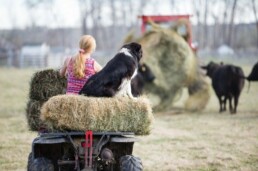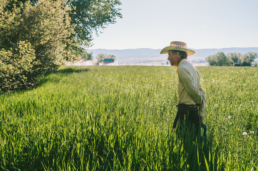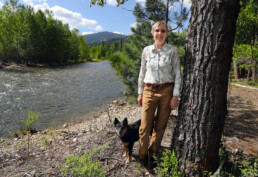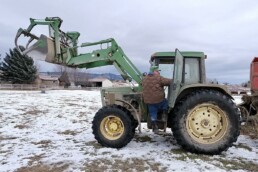Ensuring Ranches Thrive
It was sunny and warm. The perfect day for a huckleberry lemonade, conversation, and “big gun sprinklers” to keep the rhythm of the afternoon. It was an unusual break from daily chores on Kerslake Ranch, east of Stevensville.
Sari Kerslake and her mom, Julie, were in between irrigation sets. The land they’re irrigating was conserved in 2013 by Hattie Farrell, a Burnt Fork legend who ran the ranch with her late husband, George, since 1963. Back then it was a dairy, evolved into a beef cattle operation, and is now the base of operations for the Kerslake Ranch.

Overcoming Obstacles
Before this 93 acre ranch was conserved, Sari and her husband, Dan, were leasing Hattie’s place and a few other fields to grow grass hay. Over many years, they developed trust with Hattie, at first working hard, leasing the land, and then becoming friends. “She began to trust us after we had worked the land those 5 years. And that’s how it all started,” recalls Sari.
The average age of a Montana rancher is 60 years old. The Kerslakes were less than half that age at the time. Land is expensive, and in high-demand. Finding and financing land would prove to be nearly insurmountable barriers. As Sari puts it, “We looked terrible on paper. We had no money, it was tied up in equipment, and we didn’t own any land.”
After several years of working with Dan and Sari, Hattie began thinking about moving off the ranch into town, and wondering who would own the land after her. She wouldn’t just sell it to anyone.
“I grew up on a big cattle ranch and feel we should save all the ranch land we can.”
– Hatte Farrell
Hattie believed in the young Kerslake couple and reached out to them. She told Dan, “I would love to have you buy the ranch. Look at this option, it might be a way to make it work.” Hattie saw a pathway to transfer her ranch from one generation to the next. That’s when she approached BRLT to conserve her family land and help transition it to the next generation.
But the Kerslakes still needed to make buying the ranch pencil out.
They met with Ross Rodamacher at Farmers State Bank. After running all the numbers and scenarios he said, “You know, I think you kids can make this happen.” An individualized loan was created to make the transition from on ranch family to the next as seamless as possible.
A Model for the Future
Now seven years later, on this warm September day, Dan and Sari are working on some diverse business practices. Honey bees now buzz the ranch, pollinating and creating local honey. Sheep and cows dot the pastures, and their hay operation continues to grow.
“All our hay was sold before we made it this year. Which sounds great at first, but then it’s a delicate balance to achieve and deliver on all those sales,” Sari said. “Our sheep and cows graze the fields and make our ground much more productive because they naturally fertilize it. They poop on it from fall to spring.”
Sari and Dan have been thinking about the future of the ranch, now that they’ve owned it for seven years. “Dan and I think about who will come after, and if we have kids someday—or not—we’ll find someone who wants to keep this going,” smiles Sari.
“It could be young ranchers just like you, Sari,” Julie said. Mom’s words ring true for so many farming and ranching families in the Bitterroot, “Supporting open lands is supporting a tremendous amount of moving parts that sustain this valley, and keep it in the hands of the people that understand it, and keep it producing.”
Self-reliance, trust, and hard work brought this story to life. There is a way to pass on our Bitterroot way of life, our rural heritage, and ensure it is vibrant and thriving now, and for generations to come. Hattie, Dan and Sari, have provided a model showing how to do so. Together, we can help keep local agriculture and open lands thriving for future Bitterroot generations.
For Us, It Was The Right Thing To Do
There was never a dull moment at home with his mom Dolly and dad Ed. Mom worked right alongside the men. Many times outpacing them. Dad could usually be found fixing farm equipment, elbow deep in engine grease.
Running a small ranch required an “all hands on deck” approach to getting the work done.
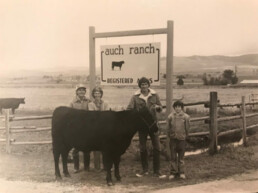
And that’s still true today.
After his dad passed away in 2014, Dwight Auch’s mom told him—with unwavering conviction in her eyes—they had to make sure the ranch stayed in ranching hands. Over time, they’d seen a great deal of farmland rapidly convert to other uses. Yet it wasn’t so simple. How could they keep it in ranching, knowing that someday they might have to sell it, even if that meant generations from now?
Future Ranchers
“It was after a lot of thought and discussion that my mom and I decided that the right thing to do, for our family, was to conserve our ranch,” explains Dwight. “We felt we could honor our family, and make it possible for future ranchers to work the land, for years to come. It just made sense.”
Given their ranching heritage, the Auchs know, perhaps better than many of us, that with the uncertainty of agriculture markets, unforeseen family hardships, and the continual growth of communities, there will likely be pressure to develop farm and ranch land.
When Dwight reflects on why he wanted to conserve the land, he quietly says “I feel so fortunate to have grown up and been able to spend so much time outside on our small cattle ranch in Corvallis. Now, there’s a greater chance that others will be able to do that in the future; it gives us peace of mind.”
“As more working land is preserved in this magnificent valley. I hope that more young people who choose agriculture as a career will be able to do so.”
– Dwight Auch
More affordable access to land is part of the solution, and often conserved lands are more affordable than those competing for the estate or development market. The Auchs see that as a real benefit.
Other ranchers and farmers are coming to the same conclusion. Thanks to you, our members and supporters, we are now in conversations with a number of local families to help them figure out if conservation is right for them.
Luck and Hard Work: Conservation Momentum Builds in Threemile
The winter sky is icy-blue, and the morning sun is golden. Surrounded by open hay fields and Threemile Creek meandering just below, Frank Mogan softly pats his new German shepherd pup, Trapper, on the scruff with his rough hands, worn from a lifetime of hard work.
Trapper’s eyes slowly blink and glint in the morning sun. It’s quiet and peaceful. Frank breaks the silence and looks up. “My mom came over to take a look,” he said. “After she took one walk up along the creek, she fell in love with it. From that day, I knew this wasn’t going to be a money-making thing.”
But Frank Mogan didn’t always feel that way. Conservation didn’t seem like an option for him and his land early on. For landowners contemplating conservation, there is much to consider. Barriers like financing, debt, resources, and misconceptions can make it difficult for farmers and ranchers to pursue a conservation outcome on their land.

Hard Work Pays Off
Frank worked for a number of years to pay down his debt and position himself to conserve the farm. He accomplished a lot through honest, hard work. “I was lucky,” Mogan said. “I’ve always had all the work that I needed to make the payments, even during the recession. Sometimes it meant that I had to travel to places like Park City, but I always had the work.”
The good news is that with programs like the NRCS (Natural Resources Conservation Services) , critical funding is available to farmers and ranchers that make projects like Frank Mogan’s pencil out. Thanks to NRCS funding, an important wildlife corridor, ¾ of a mile of Threemile Creek riparian habitat, and productive hay ground was protected, totaling 161-acres of beautiful Bitterroot Valley ground.
“I think it could have been worth millions in a heartbeat, but I don’t think I would have been any happier than I am now.”
– Frank Mogan
This critical funding helps to leverage local Open Lands Bond dollars, making it possible for farmers like Frank to protect their land do right by those that came before them. As Frank puts it, “It makes me feel great,” Mogan said. “It wouldn’t give me satisfaction if this had been developed with million-dollar homes and turned into a city. This creek and the cottonwoods are important to wildlife. And now they are always going to be there.”
Momentum in Three Mile
Frank Mogan’s farm is adjacent to another conserved family farm. The 160-acre Gates family partnered with Bitter Root Land Trust the year prior to make sure their family land and legacy could be passed on to the next generation. Sam Gates’ daughter and granddaughter will play a big role in the future of the farm.
Now, because of NRCS funding, and because Montanans care about the future of farming and ranching, Frank’s land stays in working hands.
Conservation Momentum in Stevensville
Long days, and even longer nights on their dairy farm in southern Idaho, didn’t stop Doug and Janis Astle from pursuing their dream to ranch in the Bitterroot. In fact, it fueled their desire to one day work the land here.
If you asked the Astle’s, they’d say they’re like anyone else, just living life, taking one day at a time. But their story is anything but mundane.
Many years ago, Doug and Janis traveled each year to western Montana for their sons’ football clinic. What started as a visit of necessity, turned out to be something they looked forward to every spring.
Struck by the rugged beauty of the mountains and the river, they made it their goal to ranch here one day. Janis’ eyes twinkled with the memories of those visits, “We just fell in love with this place, the Bitterroot Valley.”

A Harsh Reality
The reality is, it’s not easy to find large tracts of land for farming and ranching in the valley.
The average parcel size in the valley is 10 acres. That makes it difficult for farmers and ranchers, especially the next generation, to start and expand their own ag operation.
The good news is, conservation is making a difference.
This momentum in the Bitterroot, particularly the Burnt Fork area, is making it possible for farm and ranch lands to stay in tact and thrive. That’s exactly what drew Doug and Janis here, to continue ranching and ultimately to conserve their ranch.
Doug adds, “I know what it took for us to get this land. So I think, oh my gosh, there’s other folks like us–where in heavens are they going to find this? Land that’s not broken up?”
The Astles were given a warm welcome by neighbors and other ranchers, like Jim and Sharon Schroeder.
Sharon recalls, “When we talked with them about our conservation easement, and how they could become part of that community, they were intrigued to hear more. It is comforting to know that the ground you love and nurture will be preserved in perpetuity and that you are making the right decision for future generations. We are thankful we live in a neighborhood where we share that value of preserving agricultural lands and are grateful to the Astles for joining the Burnt Fork community.”
Without A Doubt
There’s no doubt Doug and Janis believe they made the right decision, “We were drawn to this valley by the incredible beauty, and especially to the ag lands. What sealed the deal though, were the people. They were all so good to us. So this–conserving this ranch–is how we can give back.”
The Astles are thinking long-term about who will need this land in the future.
“There’s always someone that needs a little space to have cows or whatever they’d want to farm. And if we don’t set some of this aside in this valley, that opportunity will disappear faster than we might realize.”
Thanks to the Astles, and thanks to you, we can set some land aside for the future. The next generation farmer or rancher will have the opportunity and freedom to work the land, raise cows, or grow crops.
Reunifying What Was Once Lost
Situated on an oasis of open countryside in the Illinois Bench neighborhood of Stevensville and surrounded by clusters of neighboring homes, the fate of the 150+ acre “Yoder Angus” ranch could have someday resulted in subdivision if one Bitterroot family hadn’t stepped in to conserve the property in November 2021.
The newly conserved property rests on valuable Bitterroot agricultural ground and is home to a cow-calf operation, as well as to a variety of wildlife including elk, fox, geese, ducks and hawks. The ranch is operated by Jake and Fannie Yoder who cherish the opportunity to continue a traditional way of life working in agriculture, and look forward to passing the ranch down to their three children someday.
After relocating to Stevensville from the St. Ignatius area where they ran a longtime cow-calf operation, the Yoders originally purchased 80 acres of what was at one time part of ranch nearly double in size. The “missing” adjoining 70 acres was owned by neighbors, which the Yoders eventually purchased as well. The original ranchland was now reunified in its entirety and, thanks to a conservation easement, never to be divided again.
I never dreamt that in five years we would have been able to put this farm back together. I think about that every day when I come over the top of the hill and look around. I know this is the way it will stay now. If I die tomorrow, there’s no threat that it will be sold and developed.”
– Jake Yoder, Landowner
As it turned out, the Yoders weren’t the only ones in tune with land’s value. Leading up to the completion of the conservation easement, Jake received phone calls from multiple developers inquiring about purchasing the land.
They were like, ‘Mr. Yoder, we can help you do something with your property.’ To me, that was a rude awakening. There is something about being respectful to your ground… There’s nothing wrong with a little cow manure and a little bit of green grass and being outside on your saddle horse.”
Thanks to the vision of the Yoder family, this valuable open space will continue to serve as agricultural ground and wildlife habitat, as well as a reminder of the importance of conservation amidst an area that has been heavily developed over the years.
It Feels Like a Good Situation
Pine needles and leaves crunched under her feet. The sun shone brightly in the September bluebird sky, and the West Fork River hummed along its orange, glowing tree-lined banks in Conner. Marty Stomberg smiled quietly from beneath the large brim of her hat.
She paused her steps, “We’re just here to care for the land, the best way possible.” Her family has been caretakers of this land along the West Fork River for many years. “My son, Ben, grew up here. You know, kids fledge. When he came of age, he came back. It was his playground as a kid, and he came back as an adult, wanting to care for it.”
Marty’s son, Ben, passed away tragically in 2010. This pine covered bank on the West Fork has been the family’s special place to honor Ben’s memory. And to share this peaceful spot with the entire Bitterroot community is meaningful to them. Marty recalls with glossy, blinking blue eyes, “We started thinking, this is a thing to do for Ben. It’s the thing that I’m going to do for him.”
More than just the Stomberg and White families have benefited from forested land and river access. Locals and visitors alike have been coming here to “High Bank” to wade fish, launch boats, and spend time together with family and friends for decades. All because of the generosity of Marty and her family.
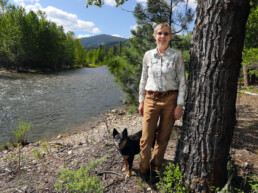
It Breaks My Heart
Marty motioned to the nature around her, “It breaks my heart we’ve lost so much river frontage, so many hot springs, and places to go. But this will be public access. Open land makes recreation available to the people of Darby, to the people of Conner. They can have a place to go to the river.”
The family knew permanently protecting the community’s access to the river was the right thing to do.
“We’ve had offers, and we turned them down because it just didn’t feel right. We started asking the Bitter Root Land Trust, ‘what if?’ What if it was a better fishing
access, a small campground? The next access is about 20 miles up the road”, said Marty.
For many years, Marty and her family, sister Barb and her husband Robert Dickman, and brother, Don White, worked with the land trust to see what is possible for this special piece of ground, and how it could benefit the people of Conner and Darby.
The road was long and difficult.
Marty and her son Ben, sister Barb, and husband Bob Dickman, and later, Ben’s father, Don White, worked diligently to keep the land intact. They cashed out retirement funds and sold other assets to put themselves in a position to make decisions for the future of their land. It was a balancing act navigating tenuous family dynamics and finances. But it was their graceful determination that made this vision come true.
Access to the River for All
And now, thanks to you, and many more caring supporters, access to the river was not lost. It was protected. Organizations and stakeholders from across the valley came together around conservation: The Open Lands Program, FWP, Connell Foundation, Ravalli County Fish & Wildlife Association, Montana Fish and Wildlife Conservation Trust, Five Valleys Audubon, and Bitterroot Audubon.
The partnership with the Stomberg and White families, the Bitter Root Land Trust, and Montana Fish,Wildlife, and Parks, ensures forest and river access for camping, fishing, horseback riding, hunting, and hiking are here to stay.
Marty says it best,
“It doesn’t feel like a compromise, really. It just feels like a good solution.”
When family and community find a way to make great conservation happen, the people of this valley benefit.
A Different Look at the Land
Lifelong Bitterroot Valley farmers and ranchers Bob and Laurie Sutherlin have spent decades establishing and growing Sutherlin Farms with a goal in mind: to keep their land in agriculture for generations to come.
Bob was only a teenager when he first started buying cows, and until they could afford to buy their own, he and his wife Laurie rented ground to run their cattle and farm.
“When you grow up not having ground and have to put it together yourself, you take a different look at that land,” says Bob. “It’s something you worked for your whole life and wanted.”
Thanks to your support, and in partnership with the Sutherlin family, Ravalli County Open Lands Bond Program, and Natural Resources Conservation Service (NRCS), BRLT was able to conserve Sutherlin Farms located along Eastside Highway between Corvallis and Stevensville this month, forever protecting 377-acres of of immensely productive and prime farmland here in Ravalli County.
Located between Corvallis and Stevensville, Sutherlin Farms rests on some of the richest soil in Ravalli County. The farm is primarily used for irrigated crop production, including hay, alfalfa, grain and silage corn, all of which are grown to feed their cow/calf operation and herd of Red Angus that now has seed stock all over the world.
“It takes good productive ground to raise enough hay to winter these cattle. You can’t just let it go away,” says Bob.
Nearly all of the farm – 99%, to be exact – is identified by NRCS as “agriculturally important soil.” In addition to prime farmland, the property’s open space provides valuable wildlife habitat as well as areas for wildlife movement, especially for locally important species such as elk, deer, sandhill crane, bald and golden eagle, and other raptors. With several other conservation easements close by and directly adjacent to the farm, the newly conserved Sutherlin Farms has added to the area’s preservation of open space near the Bitterroot River.
“At a time like this when land values are so high and the opportunity to convert that to a different use is there for all of our ag families, it makes the decision to do this that much more difficult from a financial standpoint,” says Gavin Ricklefs, BRLT Executive Director. “But it also makes it that much more laudable and appreciated. It’s a challenging decision to limit development on your land permanently. There’s not more important ground in the valley for production.”
Thanks to the decision to conserve their farm, the Sutherlin family has guaranteed the preservation and enhancement of one more section of open space in western Montana – forever.

